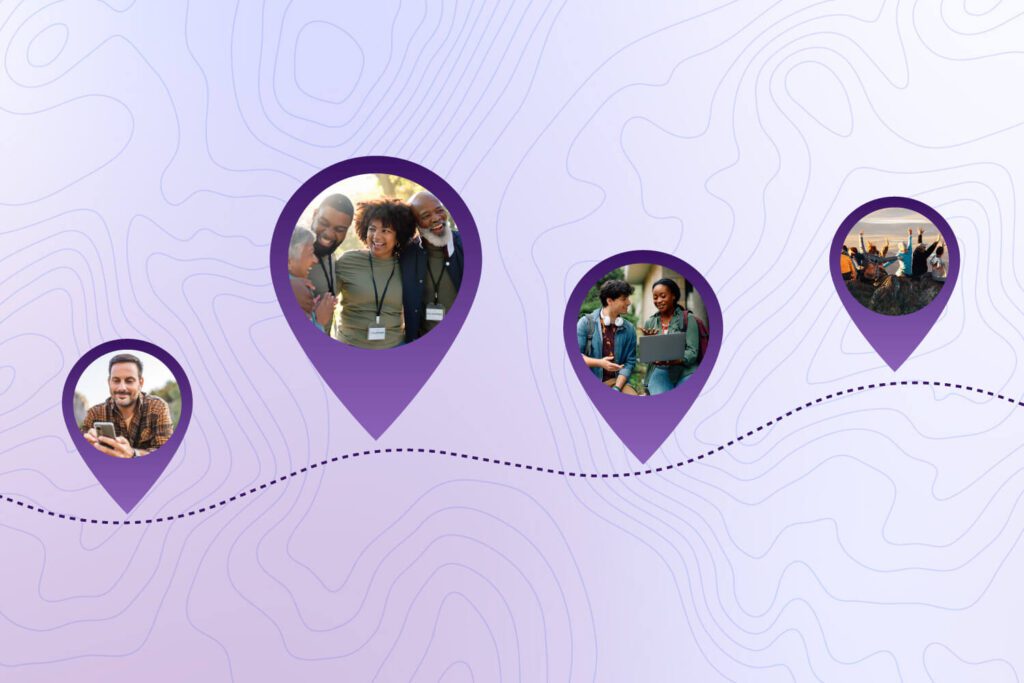The future of nonprofit fundraising and engagement

While much of your nonprofit organization’s work focuses on your current initiatives, it’s always a good idea to look ahead and think about the future of your fundraising strategies.
As you review your data and measure nonprofit KPIs, think about the actions you might take now to improve your fundraising program overall. Compare that to the trends discussed in this article to chart your nonprofit’s path to future fundraising success.
Where nonprofit fundraising is headed
What are nonprofits’ top priorities for fundraising and supporter engagement? Over the next few years, most nonprofits are aiming to expand their digital lists and acquire new supporters.
This is true, no matter the nonprofit’s size. The main difference between small and large organizations is that as the size of the nonprofit increases, priorities shift from gaining new supporters to optimizing relationships with existing ones to increase donation size and frequency.
Small nonprofits focus on fundraising growth
Smaller nonprofits typically have less stability with their fundraising programs and are still developing their donor lists. It makes sense that a majority of them rank list growth as their top priority.
Only about 20% of first-time donors will give again to a nonprofit. For small nonprofits, generating a larger list is crucial for achieving fundraising stability. Outreach to new potential donors helps to build a roster of future supporters, leading to more stable revenue over time.
Fundraising tools for small nonprofits
Small organizations can leverage their CRM to begin building relationships with supporters. You should enter every contact that visits your website or attends an event into your donor database and categorize them for future appeals.
Introduce them to your organization and slowly increase the urgency of your appeals. To do so, you can create automated nurture emails that go out to new contacts in a series of emails over the course of a month or two.
Medium and larger nonprofits focus on fundraising optimization
Established organizations with well-defined donor lists have more diverse priorities. While list growth remains an important part of their fundraising strategy, their focus shifts to other objectives like boosting donor retention, increasing the value of each donation, and turning one-time donors into recurring donors.
This is especially true for large organizations with more mature fundraising programs and the capacity to communicate with donors throughout their entire giving lifecycle.
Fundraising tools for medium to large nonprofits
For medium and large-sized nonprofits, donor management and communication are critical. A nonprofit CRM with wealth screening and email automation capabilities is indispensable for segmenting your donor lists and creating targeted communication.
The best way to turn a one-time donor into a recurring one is to let them know that their initial gift is meaningful to your organization and the people you serve. Fundraising software with case management capabilities allows you to tie a donor’s gift directly to its impact. Sharing stories of your impact and segmenting your donor lists by program or event is a great way to personalize your communications and make each message more relevant to your donors.
How nonprofits can increase engagement with supporters
Increased engagement leads to an increase in supporter growth and eventually an increase in fundraising revenue. To connect with donors, nonprofits should have a reasonable understanding of which platforms will lead to the greatest engagement.
Email has been a long-term staple of communication. Social media websites can lead to spikes in traffic, but they can come and go within a few years. Mobile traffic has continued to outpace desktop traffic, and the portion of donations coming from mobile devices has also increased along with the use of SMS and text-to-donate.
Ultimately, nonprofits should focus on a multi-channel marketing approach, though the number of channels will depend on each organization’s capacity.
Supporter engagement at small nonprofits
Small nonprofits rely heavily on social media marketing due to its wide reach and low cost of entry. Email, which is also widespread and relatively low-cost, can offer high growth for nonprofits as well.
Outside of email and social media, nonprofits believe peer-to-peer programs will offer the next highest level of growth for their organization. Peer-to-peer fundraising software can amplify your nonprofit’s message and expand your network to your supporters’ friends and family, making it a great way for smaller nonprofits to grow their donor lists and increase their donations.
Supporter engagement at medium nonprofits
As organizations grow in size and revenue, staff capacity increases and nonprofits can add additional marketing channels to their fundraising outreach.
For medium-sized nonprofits, email and social media are still the main channels predicted to help growth. Texting can be another opportunity for growth for these organizations.
Supporter engagement at large nonprofits
Larger nonprofits perform outreach through a more diverse group of digital channels, and their predictions for fundraising growth are similarly dispersed. Large organizations typically have the capacity for dedicated staff to handle social media interactions, email communications, and events.
Large nonprofits distinguish themselves from their smaller counterparts by focusing on other digital channels as drivers for growth, such as in-person and hybrid events. While small and medium nonprofits concentrate on optimizing their existing channels, larger nonprofits that can afford bigger and more frequent events see them as a productive means to increase supporter engagement and fundraising growth.
The future of nonprofit fundraising and engagement
Organizations of all sizes looking to attract new donors will need strategies for nurturing the supporters they acquire on each marketing channel.
Constant communication with your donors is critical, and more specifically, relevant messages will help you retain them. Now, more than ever before, a nonprofit CRM offers an efficient way to ensure your supporters receive the right stewarding messages, through the right channels, at the right time.
Ready to Get Started?
Work with Bonterra



